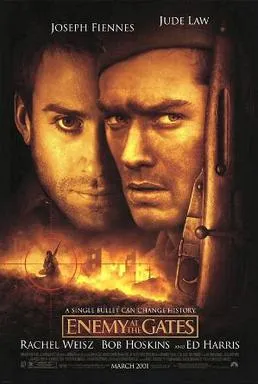Historical accuracy of Enemy at the Gates

Historical accuracy of Enemy at the Gates

Characters
Vasily Zaitsev
Based on the real Hero of the Soviet Union, Vasily Zaitsev. His sniping achievements at Stalingrad and his role as a propaganda icon are historical, although specific events are dramatized.
Major Erwin König
Zaitsev's memoirs mention a duel with a German sniper school head named Konings/Thorvald, but German records do not confirm König's existence or rank. Many historians believe he was likely propaganda or fictional.
Commissar Danilov
A fictional character representing the role of political commissars and the Soviet propaganda machine. His specific actions and the love triangle are invented for the film.
Tania Chernova
Based on accounts of a female sniper who knew Zaitsev, but her existence and relationship with him are debated by historians and not prominent in Zaitsev's own memoirs. Her film storyline is heavily fictionalized.
Nikita Khrushchev
Based on the real Khrushchev, who was the senior political figure directing the Stalingrad defense. His portrayal captures his known ruthlessness and involvement, though specific scenes are dramatized.
Koulikov
A fictional character used for exposition (explaining König's background) and dramatic effect (being killed by König).
More characters
Sasha Filippov
Based on a real young Soviet scout/spy in Stalingrad. However, his specific interactions with Zaitsev and König, his role as a double agent, and his manner of death are fictionalized for the plot.
Mother Filippov
A fictional character tied to the Sasha Filippov subplot, representing the plight of civilians trapped in the battle.
Story
Initial charge with one rifle per two soldiers
This depicts a common myth. While equipment shortages existed, especially early in the war or in penal units, sending regular troops into attack deliberately unarmed on this scale was not standard practice at Stalingrad.
NKVD blocking detachments shooting retreating Soviets
Blocking units existed under Order No. 227 to prevent unauthorized retreats, but the film likely exaggerates the frequency and scale of them machine-gunning their own troops. Their main role was often less lethal deterrence.
Zaitsev's skill discovered during chaotic battle
Zaitsev was recognized for his marksmanship, but the specific fountain scene where Danilov witnesses his initial five kills is a fictionalized dramatic invention.
Zaitsev elevated to hero status by propaganda
The Soviet propaganda apparatus heavily promoted Zaitsev's exploits in newspapers and radio to boost morale during the desperate battle, making him a national hero.
Extended, personal sniper duel: Zaitsev vs. König
This central plot is based on Zaitsev's account of hunting a German sniper chief (Konings/Thorvald), but lacks German corroboration. The specific details and duration of the duel are likely fictional or exaggerated.
Love triangle involving Zaitsev, Tania, and Danilov
This entire romantic subplot is a fictional addition created for dramatic purposes and has no basis in historical accounts.
Khrushchev's direct command presence and threats
Khrushchev was a key political leader on site, involved in strategy and maintaining discipline, often harshly. The specific dialogues and interactions are likely dramatized.
Soviets defending the Tractor Factory / industrial areas
Control of Stalingrad's large factories (Red October, Barrikady, Tractor Factory) was central to the battle, involving brutal close-quarters fighting depicted in the film.
Sasha Filippov used by König, later hanged
While based on a real boy spy, Sasha Filippov's role as König's informant and his specific death (being hanged by König) are fictional plot devices. The real Sasha was reportedly shot by the Germans.
Use of psychological warfare (propaganda leaflets, speakers)
Both sides used extensive propaganda, including leaflets, loudspeakers, and radio broadcasts, to demoralize the enemy, a feature of the battle reflected in the film.
Overall depiction of brutal urban combat
The film effectively portrays the savage, close-range fighting through ruins, sewers, and destroyed buildings characteristic of the Battle of Stalingrad.
Zaitsev wounded by artillery
The real Vasily Zaitsev was seriously wounded by a mortar or artillery shell in January 1943, damaging his eyes (though he eventually recovered and returned to service).
Setting
Devastated city of Stalingrad
The film's production design excels in recreating the vast, apocalyptic landscape of destruction – bombed-out buildings, rubble, and ruined factories – typical of Stalingrad.
Soviet uniforms and equipment
Generally accurate portrayal of Red Army uniforms (telogreika jackets, pilotka caps, helmets) and personal equipment appropriate for the winter of 1942-43.
German uniforms and equipment
Generally accurate representation of Wehrmacht uniforms, helmets, and gear for the period and theatre, showing wear appropriate for the battle conditions.
Sniper rifles (Mosin-Nagant, Mauser K98k)
The iconic sniper rifles used by Zaitsev (scoped Mosin-Nagant M1891/30) and König (scoped Mauser Kar98k) are accurately depicted, along with other period small arms.
Atmosphere of fear, desperation, brutality
Effectively conveys the intense psychological stress, constant danger, filth, cold, hunger, and pervasive brutality experienced by combatants and civilians during the battle.
Depiction of winter conditions
The film shows the onset of the harsh Russian winter, a crucial factor that hampered the German army and contributed significantly to their eventual defeat at Stalingrad.
Volga River crossing under fire
Represents the extremely hazardous crossings of the Volga River, which were vital for Soviet resupply and reinforcement but constantly under German artillery and air attack.
